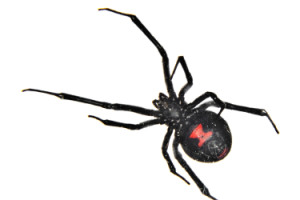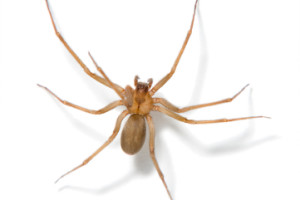
Black Widow Spider
Appearance
Dark colored spiders, 8 legs, with distinctive markings
Color
Females are black with an hourglass shape on their undersides – it’s typically red or yellow; males are lighter and have a reddish-brown strip of color down their backs
Size
Approximately 9 – 13 millimeters long with legs extended
Habitat
Dark, sheltered places; dampness is tolerated during warmer months
Interesting Facts
The female’s venom is 15 times as potent as the venom of the rattlesnake
About the Black Widow Spider
During warmer months, black widows are commonly found in dim, covered places, such as in wood piles, under foliage, as well as in basements and outbuildings. During colder months, they seek more shelter, which is when many business owners will spot them indoors.
After mating in early spring, the female kills the male and lays a large number of eggs within a gray-colored, haphazard sac. Anywhere from 200 to 900 eggs are contained in a sac, but only a few will make it to adulthood to reproduce.
Feeding on other insects mainly, even baby black widows are carnivorous when hatched.
Black Widow Spider Control
Because they are venomous, the black widow spider should be treated with care. Indoors, use a vacuum to remove the spider and/or the egg sac. Outdoors, gloves should be worn.
Black widow spiders are elusive, and unless provoked, they typically keep to themselves; however, for safety reasons, it’s important to keep them out of your space.

Brown Recluse Spider
Appearance
Smaller spider with six eyes, and a distinct fiddle shape on it’s back.
Color
Light to dark brown, also can be found in cream colors and blacks
Size
6 – 20 millimeters in length
Habitat
In irregularly spun webs in dry and undisturbed locations
Interesting Facts
Their markings are distinct. A black line running from the thorax connects to a violin shaped marking pointing toward the back of the spider.
About the Brown Recluse Spider
Brown recluse spiders are very secluded pests. Adult spiders only live for about two years, but females produce multiple egg sacs during warmer months, each containing approximately 50 eggs.
While they remain in their web most of the time, this species is known to leave at night to hunt – males more than females.
Brown Recluse Spider Control
While less than 50% of brown recluse spider bites result in severe illness and injury, they are poisonous and should be approached with care.
Prevention is the best way to counteract an infestation, and inspection by trained specialists who are adept at locating and eliminating adult spiders and breeding sites.

